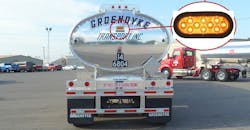FMCSA grants Groendyke exemption for brake-actuated, pulsing lamp
Groendyke Transport, of Enid OK, recently was granted a limited five-year exemption to allow use of an amber brake-activated pulsating lamp on its trailers in addition to the steady-burning brake lamps required by the Federal Motor Carrier Safety Regulations (FMCSR).
Issued by the Federal Motor Carrier Safety Administration, the exemption took effect April 26, 2019 and runs through April 26, 2024.
Brian Gigoux, Groendyke Transport vice-president of equipment and maintenance, welcomed the FMCSA announcement, saying: “We are very pleased that FMCSA has granted us this trailer brake light exemption. Our data shows that it has played a significant role in decreasing the number of rear-end collisions due to distracted driving. This is not just a win for Groendyke Transport; it’s a win for the safety of the motoring public.”
FMCSA officials said the agency had determined that placing a brake-activated pulsating lamp, in addition to the required steady-burning brake lamps, on the rear of Groendyke Transport’s trailers would likely achieve a level of safety equivalent to or greater than the level of safety provided by the federal brake light regulation.
The FMCSRs currently require all exterior lamps (both required lamps and any additional lamps) to be steady-burning, except turn signal lamps, hazard warning signal lamps, school bus warning lamps, amber warning lamps or flashing warning lamps on tow trucks and commercial motor vehicles (CMV) transporting oversized loads, and warning lamps on emergency and service vehicles authorized by state or local authorities.
In the application filed with FMCSA, Groendyke officials said the tank truck carrier “assessed what it could do to prevent other drivers from rear ending Groendyke Transport trailers, and determined that increasing visibility of Groendyke trailers would be an efficient means to prevent rear-end accidents. To this end, Groendyke Transport searched for ways to cause its braking system to capture the attention of other drivers faster and more completely.”
“We took a scientific approach to ensure a high-quality outcome,” Gigoux said. “Our goal was to improve safety, particularly when it comes to dealing with distracted drivers and rear-end collisions. We started with trailers urban areas with lots of stop-and-go driving and later expanded the experiment to include our long-haul fleet.
“The high-mounted pulsing lamp at the rear of the trailer is wired into the brake circuit, so it only flashes when the brakes are applied. The light is mounted high enough to be visible several vehicle lengths back, further increasing safety. We also fitted trucks and trailers with higher intensity LED brake lights and sequential arrow turning signals.
“Outfitting the trailers with the high-mounted brake light was done in-house and cost about $200 per vehicle for the pulsing light and roughly $850 for older trailers requiring a full complement of lights. We considered using aircraft-grade strobe lights, but discovered they would distract other drivers.
Beginning in the second quarter of 2015, Groendyke Transport began an amber brake-activated pulsating lamp on some of its fleet without authorization from FMCSA to compare the frequency of rear-end collisions between (1) trailers equipped with both centrally-mounted amber brake-activated pulsating lamp and the required steady-burning lamps, and (2) trailers equipped with only the steady-burning lamps required by the FMCSRs.
As of July 31, 2017, Groendyke had outfitted 632 of its 1,440 trailers with an amber brake-activated pulsating lamp.
Data gathered by Groendyke from January 2015 through July 2017 show that trailers equipped with both the amber brake-activated pulsating lamp and the steady-burning brake lamps were involved in 33.7% fewer rear-end collisions as compared to vehicles equipped with only the steady-burning brake lamps.
Groendyke also analyzed its data to determine whether the presence of the amber brake-activated pulsating lamp improved outcomes when drivers were slowing or stopping at railroad crossings. Groendyke found that trailers equipped with the amber brake-activated pulsating lamp were not involved in rear-end crashes at a railroad crossing during the same time period.
As cargo tank operators hauling hazardous materials, Groendyke drivers are required to stop or slow significantly at railroad crossings (49 CFR 392.10-392.12). Groendyke officials note that railroad crossings are a significant source of rear-end collisions for tank truck carriers because non-commercial drivers may not anticipate that the hazmat vehicles must stop at railroad crossings.
FMCSA officials noted in the exemption ruling that rear-end crashes generally account for approximately 30% of all crashes. These types of crashes often result from a failure to respond (or delays in responding) to a stopped or decelerating lead vehicle. Data between 2010 and 2016 show that large trucks are consistently three times more likely than other vehicles to be struck in the rear in two-vehicle fatal crashes.
